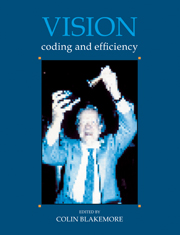Book contents
- Frontmatter
- Contents
- List of Contributors
- Preface
- Reply
- Acknowledgements
- Concepts of coding and efficiency
- Efficiency of the visual pathway
- Colour
- Brightness, adaptation and contrast
- Development of vision
- 19 On reformation of visual projection: cellular and molecular aspects
- 20 Retinal pathways and the developmental basis of binocular vision
- 21 Development of visual callosal connections
- 22 Sensitive periods in visual development: insights gained from studies of recovery of visual function in cats following early monocular deprivation or cortical lesions
- 23 The developmental course of cortical processing streams in the human infant
- 24 Maturation of mechanisms for efficient spatial vision
- 25 The puzzle of amblyopia
- Depth and texture
- Motion
- From image to object
- Index
25 - The puzzle of amblyopia
Published online by Cambridge University Press: 05 May 2010
- Frontmatter
- Contents
- List of Contributors
- Preface
- Reply
- Acknowledgements
- Concepts of coding and efficiency
- Efficiency of the visual pathway
- Colour
- Brightness, adaptation and contrast
- Development of vision
- 19 On reformation of visual projection: cellular and molecular aspects
- 20 Retinal pathways and the developmental basis of binocular vision
- 21 Development of visual callosal connections
- 22 Sensitive periods in visual development: insights gained from studies of recovery of visual function in cats following early monocular deprivation or cortical lesions
- 23 The developmental course of cortical processing streams in the human infant
- 24 Maturation of mechanisms for efficient spatial vision
- 25 The puzzle of amblyopia
- Depth and texture
- Motion
- From image to object
- Index
Summary
Introduction
Science is analogous to doing a jig-saw puzzle where the overall picture is unknown. One of two strategies can be adopted. The obvious one is first to see which individual pieces best fit together and hope to obtain a better idea of the overall picture as more of the puzzle is completed. However if there are many pieces and the picture very complicated then this may not be successful. Another method is to hazard a guess at what the overall picture might be and then to segregate pieces on the basis of this, only then beginning to put individual pieces together. While the initial guess might not turn out to be totally correct, as time goes on and more pieces are segregated, it can be further refined.
Research into amblyopia has so far followed the first of these two strategies. Over the past decade or so a number of workers have been busy seeing how individual pieces to the amblyopia puzzle fit without much regard for what the overall completed picture might look like. Initially this might be a sensible approach but we have now reached the point where it might be useful to hazard a guess at what the overall picture might look like so that more key pieces can be sought. In this paper we will consider three different types of pictures of amblyopia and assess into which the already collected pieces best fit. We stress that these are ‘pictures’ in the broadest sense, for not enough pieces have been collected to be able to assess them in the detail that we would like.
- Type
- Chapter
- Information
- VisionCoding and Efficiency, pp. 267 - 280Publisher: Cambridge University PressPrint publication year: 1991
- 3
- Cited by



